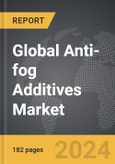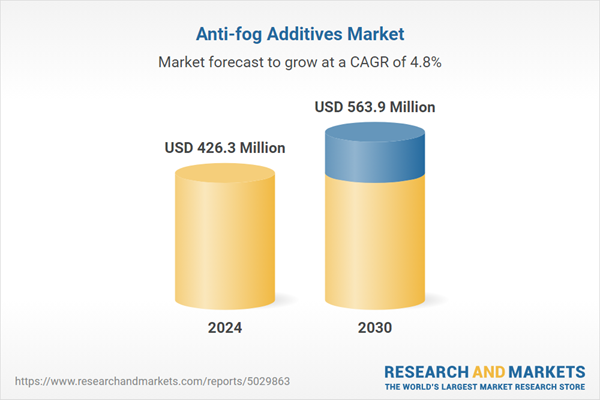The global market for Anti-fog Additives was valued at US$426.3 Million in 2024 and is projected to reach US$563.9 Million by 2030, growing at a CAGR of 4.8% from 2024 to 2030. This comprehensive report provides an in-depth analysis of market trends, drivers, and forecasts, helping you make informed business decisions.
Global Anti-fog Additives Market - Key Trends and Drivers Summarized
Why Are Anti-Fog Additives Essential in Various Industries?
Anti-fog additives are crucial components in various industries, significantly enhancing the functionality and safety of transparent materials. These additives prevent the formation of fog on surfaces by reducing surface tension, ensuring clarity and visibility. In industries such as automotive, packaging, agriculture, and construction, anti-fog additives are indispensable. For example, in the automotive sector, they are used in windshields, mirrors, and windows to maintain clear vision in various weather conditions, thereby improving safety. In packaging, anti-fog additives are applied to food packaging films to prevent condensation, ensuring that the contents remain visible and appealing to consumers. In agriculture, they help maintain the transparency of greenhouse films, promoting optimal light transmission for plant growth. The construction industry also benefits from these additives in applications like glass windows and shower enclosures, where maintaining visibility is critical.How Are Technological Advancements Enhancing Anti-Fog Additives?
Technological advancements are significantly enhancing the efficacy and versatility of anti-fog additives. Innovations in chemical formulations have led to the development of more effective and longer-lasting solutions. For instance, the introduction of hydrophilic coatings has improved the durability and performance of anti-fog treatments. These coatings work by creating a thin, uniform layer of water, rather than droplets, which maintains clarity. Additionally, advancements in nanotechnology have enabled the creation of anti-fog additives with superior adhesion and performance characteristics. These nano-coatings provide a more robust barrier against fogging and are more resistant to abrasion and cleaning. Moreover, the development of environmentally friendly and non-toxic additives addresses growing regulatory and consumer demands for sustainable products. These technological improvements are making anti-fog additives more reliable and applicable across a broader range of industries.Why Is the Demand for Anti-Fog Additives Increasing in Consumer Goods?
The demand for anti-fog additives is increasing in the consumer goods sector due to the growing emphasis on safety, convenience, and product performance. In the eyewear industry, anti-fog treatments are becoming standard for lenses, particularly for sports and safety goggles, where clear vision is crucial. Consumer electronics, such as cameras and smartphones, are incorporating anti-fog technologies to enhance user experience and protect internal components. The home and personal care market is also seeing increased adoption, with anti-fog treatments being used in bathroom mirrors and windows to prevent fogging in humid conditions. This rising demand reflects a broader trend towards enhancing the functionality and user experience of everyday products.What Factors Are Driving Growth in the Anti-Fog Additives Market?
The growth in the anti-fog additives market is driven by several factors related to technological advancements, expanding applications, and evolving consumer preferences. Innovations in chemical and nano-coating technologies have significantly improved the performance and durability of anti-fog additives, making them more attractive to a variety of industries. The increasing demand for safety and convenience in consumer goods, such as eyewear, face shields, and electronic devices, is a major driver. The heightened focus on sustainability and regulatory compliance is propelling the development of environmentally friendly and non-toxic additives. Additionally, the expansion of the automotive and packaging industries, particularly in emerging markets, is fueling demand for high-performance anti-fog solutions. As industries continue to prioritize product performance and user safety, the demand for advanced anti-fog additives is expected to sustain robust growth.Report Scope
The report analyzes the Anti-fog Additives market, presented in terms of market value (US$ Thousand). The analysis covers the key segments and geographic regions outlined below.Segments
Type (Glycerol Esters, Polyglycerol Esters, Sorbitan Esters of Fatty Acids, Polyoxyethylene Esters of Oleic Acid, Ethoxylated Sorbitan Esters, Other Types); Application (Food Packaging, Agricultural Films, Other Applications).Geographic Regions/Countries
World; United States; Canada; Japan; China; Europe (France; Germany; Italy; United Kingdom; Spain; Russia; and Rest of Europe); Asia-Pacific (Australia; India; South Korea; and Rest of Asia-Pacific); Latin America (Argentina; Brazil; Mexico; and Rest of Latin America); Middle East (Iran; Israel; Saudi Arabia; United Arab Emirates; and Rest of Middle East); and Africa.Key Insights:
- Market Growth: Understand the significant growth trajectory of the Glycerol Esters segment, which is expected to reach US$191.6 Million by 2030 with a CAGR of a 5.5%. The Polyglycerol Esters segment is also set to grow at 4.9% CAGR over the analysis period.
- Regional Analysis: Gain insights into the U.S. market, valued at $111.2 Million in 2024, and China, forecasted to grow at an impressive 7.5% CAGR to reach $125.8 Million by 2030. Discover growth trends in other key regions, including Japan, Canada, Germany, and the Asia-Pacific.
Report Features:
- Comprehensive Market Data: Independent analysis of annual sales and market forecasts in US$ Million from 2024 to 2030.
- In-Depth Regional Analysis: Detailed insights into key markets, including the U.S., China, Japan, Canada, Europe, Asia-Pacific, Latin America, Middle East, and Africa.
- Company Profiles: Coverage of major players such as A. Schulman, Inc., Addcomp Holland BV, Akzo Nobel NV, Ampacet Corporation, Ashland, Inc. and more.
- Complimentary Updates: Receive free report updates for one year to keep you informed of the latest market developments.
Why You Should Buy This Report:
- Detailed Market Analysis: Access a thorough analysis of the Global Anti-fog Additives Market, covering all major geographic regions and market segments.
- Competitive Insights: Get an overview of the competitive landscape, including the market presence of major players across different geographies.
- Future Trends and Drivers: Understand the key trends and drivers shaping the future of the Global Anti-fog Additives Market.
- Actionable Insights: Benefit from actionable insights that can help you identify new revenue opportunities and make strategic business decisions.
Key Questions Answered:
- How is the Global Anti-fog Additives Market expected to evolve by 2030?
- What are the main drivers and restraints affecting the market?
- Which market segments will grow the most over the forecast period?
- How will market shares for different regions and segments change by 2030?
- Who are the leading players in the market, and what are their prospects?
Some of the 13 major companies featured in this Anti-fog Additives market report include:
- A. Schulman, Inc.
- Addcomp Holland BV
- Akzo Nobel NV
- Ampacet Corporation
- Ashland, Inc.
- Clariant AG
- Corbion NV
- Croda International PLC
- Dow, Inc.
- DuPont de Nemours, Inc.
- Emery Oleochemicals Group
- Evonik Industries AG
- Fine Organics
- Palsgaard A/S
- Pcc Chemax, Inc.
- PolyOne Corporation
- Polyvel, Inc.
Table of Contents
I. METHODOLOGYII. EXECUTIVE SUMMARY2. FOCUS ON SELECT PLAYERSIII. MARKET ANALYSISSOUTH KOREAREST OF ASIA-PACIFICARGENTINABRAZILMEXICOREST OF LATIN AMERICAIRANISRAELSAUDI ARABIAUNITED ARAB EMIRATESREST OF MIDDLE EASTIV. COMPETITION
1. MARKET OVERVIEW
3. MARKET TRENDS & DRIVERS
4. GLOBAL MARKET PERSPECTIVE
UNITED STATES
CANADA
JAPAN
CHINA
EUROPE
FRANCE
GERMANY
ITALY
UNITED KINGDOM
SPAIN
RUSSIA
REST OF EUROPE
ASIA-PACIFIC
AUSTRALIA
INDIA
LATIN AMERICA
MIDDLE EAST
AFRICA
Companies Mentioned (Partial List)
A selection of companies mentioned in this report includes, but is not limited to:
- A. Schulman, Inc.
- Addcomp Holland BV
- Akzo Nobel NV
- Ampacet Corporation
- Ashland, Inc.
- Clariant AG
- Corbion NV
- Croda International PLC
- Dow, Inc.
- DuPont de Nemours, Inc.
- Emery Oleochemicals Group
- Evonik Industries AG
- Fine Organics
- Palsgaard A/S
- Pcc Chemax, Inc.
- PolyOne Corporation
- Polyvel, Inc.
Table Information
| Report Attribute | Details |
|---|---|
| No. of Pages | 182 |
| Published | April 2025 |
| Forecast Period | 2024 - 2030 |
| Estimated Market Value ( USD | $ 426.3 Million |
| Forecasted Market Value ( USD | $ 563.9 Million |
| Compound Annual Growth Rate | 4.8% |
| Regions Covered | Global |









